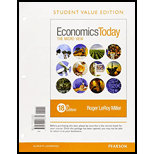
The factors that determine the
Concept Introduction:
Price Elasticity of Demand – If for a one unit change in the price, the demand increases more than proportionately the demand is said to be elastic. If however, the responsive change in demand is less than proportionate the demand is said to be inelastic while it is said to be unit elasticity if the percentage change in demand is equal to the percentage change in price. If elasticity is ‘e’ then it is defined as:
If e > 1, the demand is elastic
e < 1, the
e = 1, the demand is unit elastic
e → ∞, the demand is perfectly elastic
e = 0, the demand is perfectly inelastic
Total Revenue- It is the total earnings of the producer/seller by selling Q units of output each at a price of P. Functionally, it is written as:
The factors that affect the price elasticity are:
1) Substitution effect or substitutes- As the price of a good/service rises, the consumers, working under the assumption of rationality, look for substitutes of this good/service yielding the same or nearly the same utility. The cheaper substitutes thus come to be a part of the consumers’ consumption basket. The demand for the good thus falls and that for the substitute rises. The demand for the goods with close substitutes like tea and coffee or coke and Pepsi is thus highly elastic.
This is also known as the cross-price elasticity of demand etc. It shows the percentage change in the quantity demanded of a good, let’s say X, as the price of its substitute Y changes. Algebraically, it is written as:
2) Income Effect- The increase in the price causes a fall in the real income of the consumers. Real income is the nominal income adjusted for the prices. If the same nominal income is able to purchase fewer units of a good than before due to a rise in the price, the income is said to have lost its
This is also known as the income elasticity of demand eY. It shows the percentage change in the quantity demanded of a good, let’s say X, as the income(Y) of the consumer changes. Algebraically, it is written as:
3) Necessities vs luxuries- A price change of the goods forming a part of the staple or basic needs basket of the consumer like groceries does not affect its demand much. The price elasticity of demand for these goods is thus relatively inelastic. The demand for luxuries like a high-end car, fine dining at an expensive restaurant, a vacation in a foreign country etc. is highly elastic. A change in the prices of such luxury goods/services thus significantly affects its demand.
4) Short vs Long term- The demand is relatively inelastic in the short run while that, in the long run, is elastic. For example, the demand for diesel by a manufacturer for the production of goods is inelastic in the short run as he cannot make adjustments in the production process or equipment. In the long run, however, the manufacturer can resort to fuel-efficient production technology and employ advanced equipment if the prices of diesel continue to rise. He would substitute diesel for a more cost-effective fuel in the long run. In the long run thus, demand is more elastic.
Want to see the full answer?
Check out a sample textbook solution
Chapter 19 Solutions
Economics Today: The Micro View, Student Value Edition (18th Edition)

 Principles of Economics (12th Edition)EconomicsISBN:9780134078779Author:Karl E. Case, Ray C. Fair, Sharon E. OsterPublisher:PEARSON
Principles of Economics (12th Edition)EconomicsISBN:9780134078779Author:Karl E. Case, Ray C. Fair, Sharon E. OsterPublisher:PEARSON Engineering Economy (17th Edition)EconomicsISBN:9780134870069Author:William G. Sullivan, Elin M. Wicks, C. Patrick KoellingPublisher:PEARSON
Engineering Economy (17th Edition)EconomicsISBN:9780134870069Author:William G. Sullivan, Elin M. Wicks, C. Patrick KoellingPublisher:PEARSON Principles of Economics (MindTap Course List)EconomicsISBN:9781305585126Author:N. Gregory MankiwPublisher:Cengage Learning
Principles of Economics (MindTap Course List)EconomicsISBN:9781305585126Author:N. Gregory MankiwPublisher:Cengage Learning Managerial Economics: A Problem Solving ApproachEconomicsISBN:9781337106665Author:Luke M. Froeb, Brian T. McCann, Michael R. Ward, Mike ShorPublisher:Cengage Learning
Managerial Economics: A Problem Solving ApproachEconomicsISBN:9781337106665Author:Luke M. Froeb, Brian T. McCann, Michael R. Ward, Mike ShorPublisher:Cengage Learning Managerial Economics & Business Strategy (Mcgraw-...EconomicsISBN:9781259290619Author:Michael Baye, Jeff PrincePublisher:McGraw-Hill Education
Managerial Economics & Business Strategy (Mcgraw-...EconomicsISBN:9781259290619Author:Michael Baye, Jeff PrincePublisher:McGraw-Hill Education





